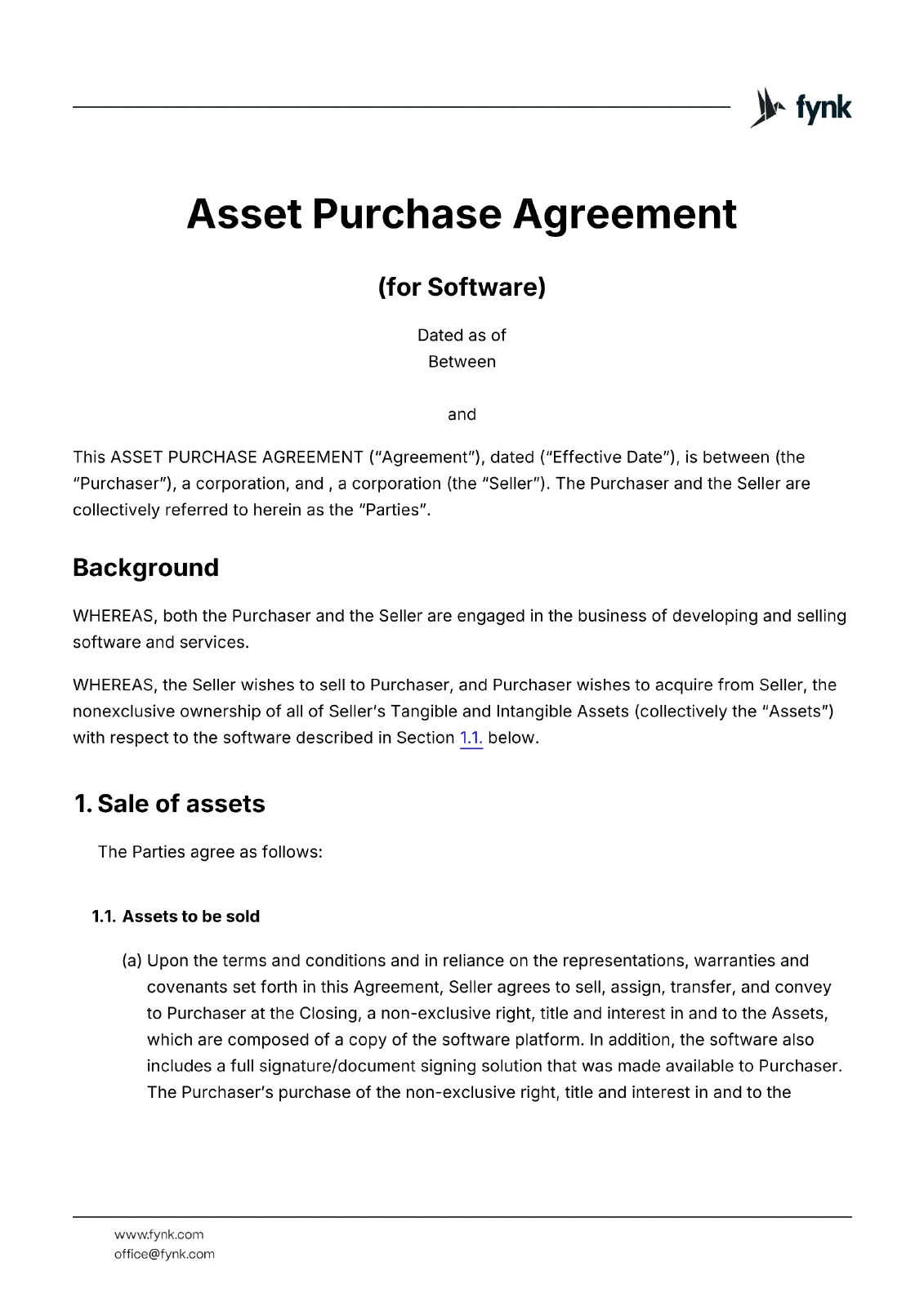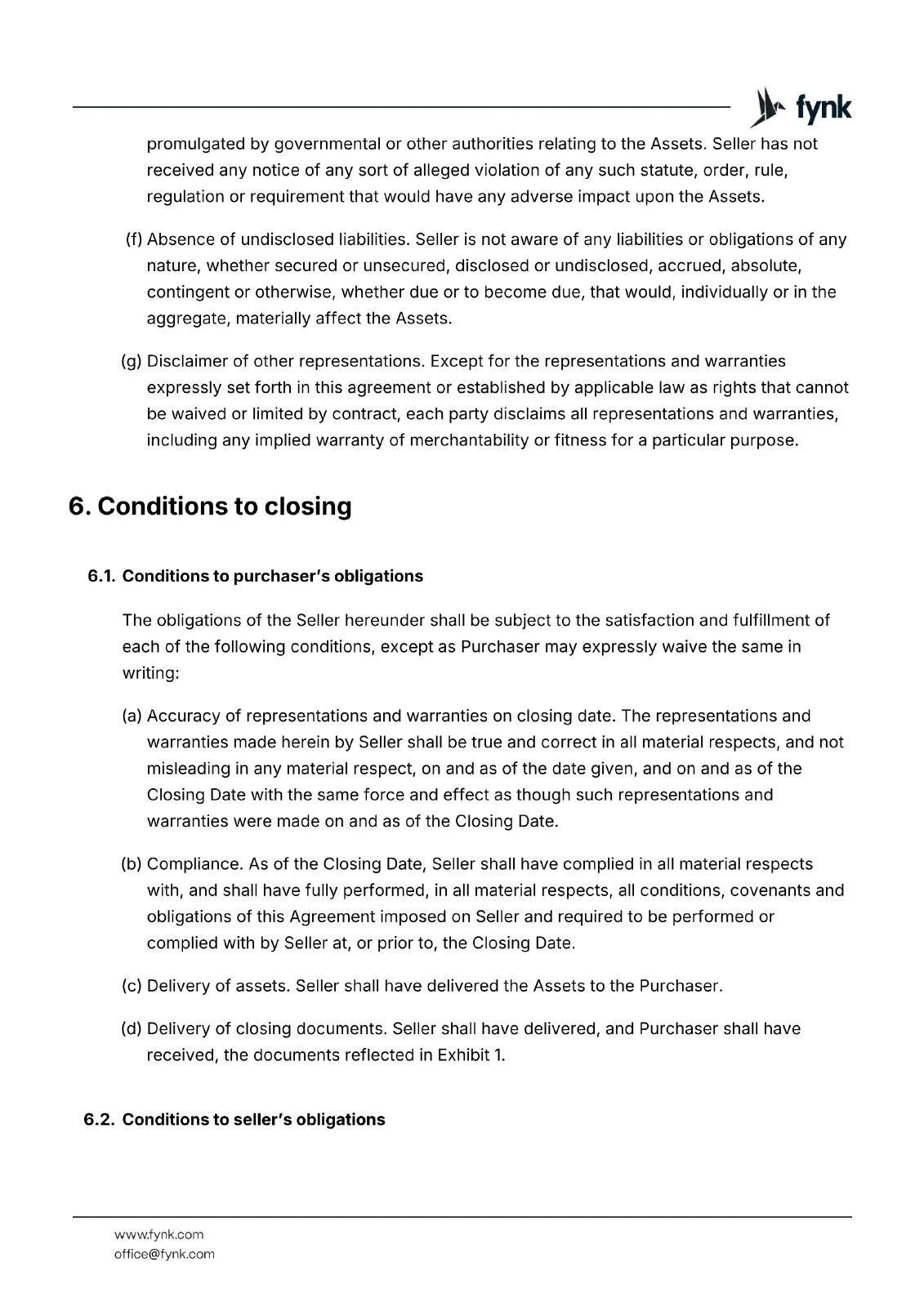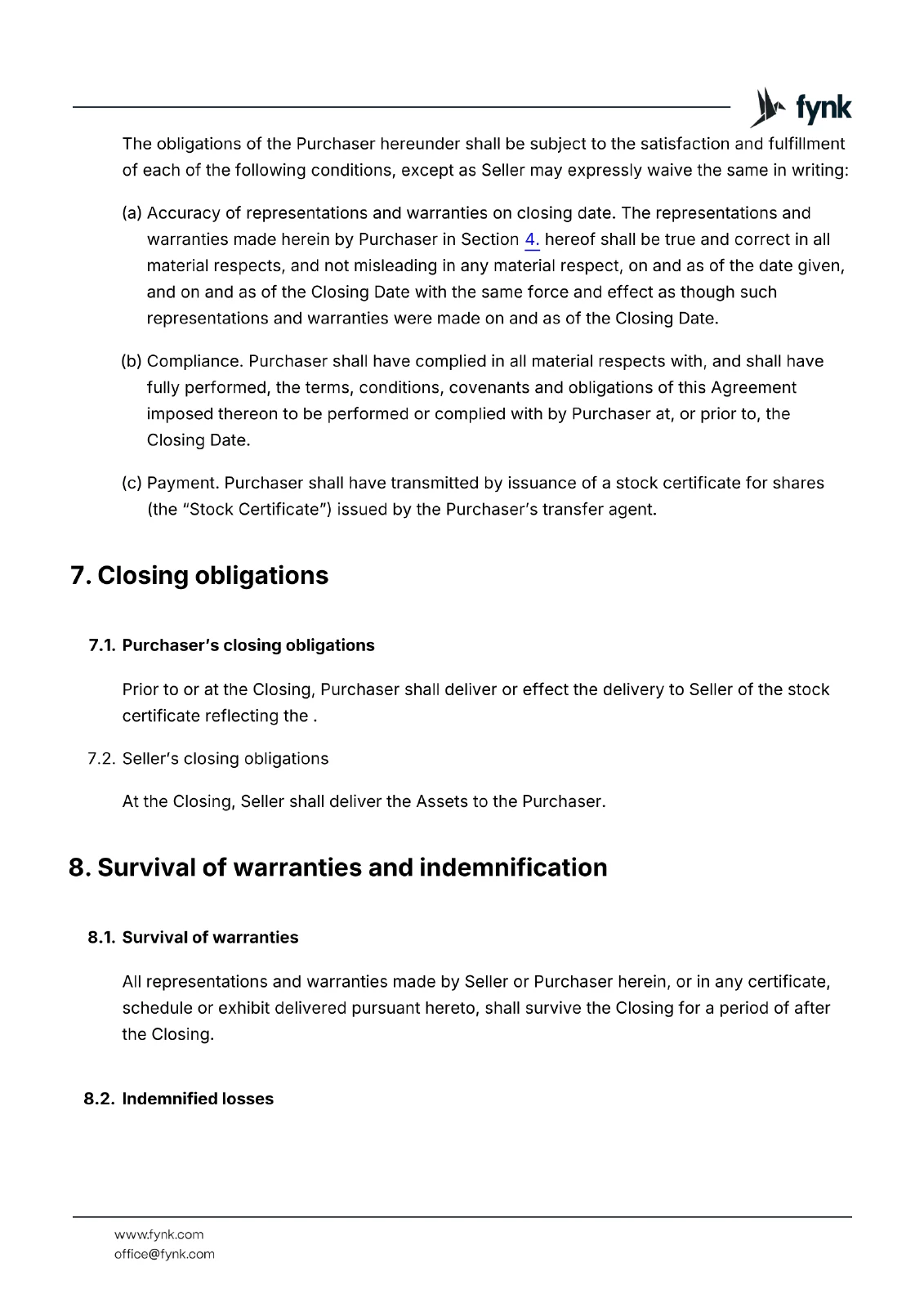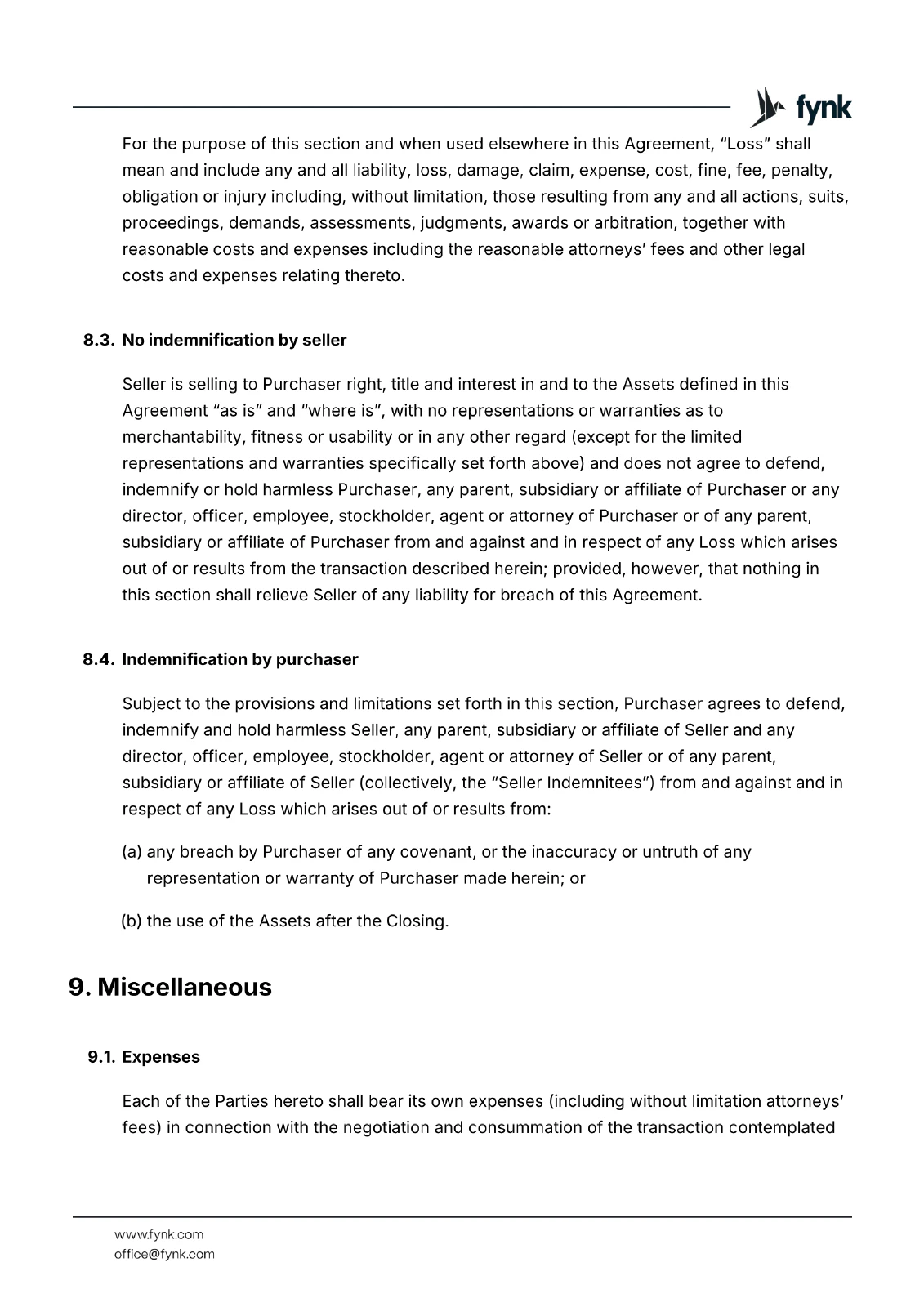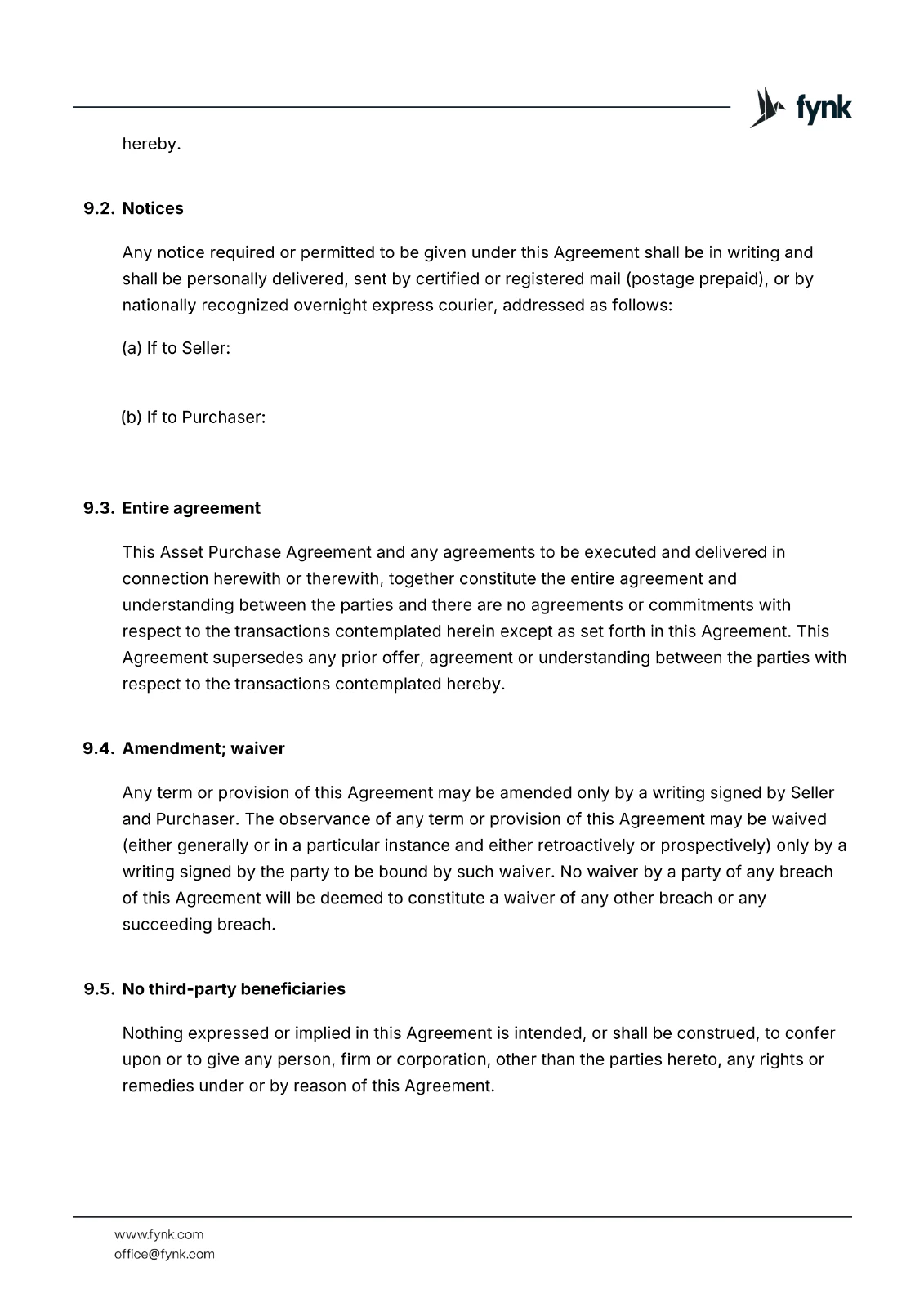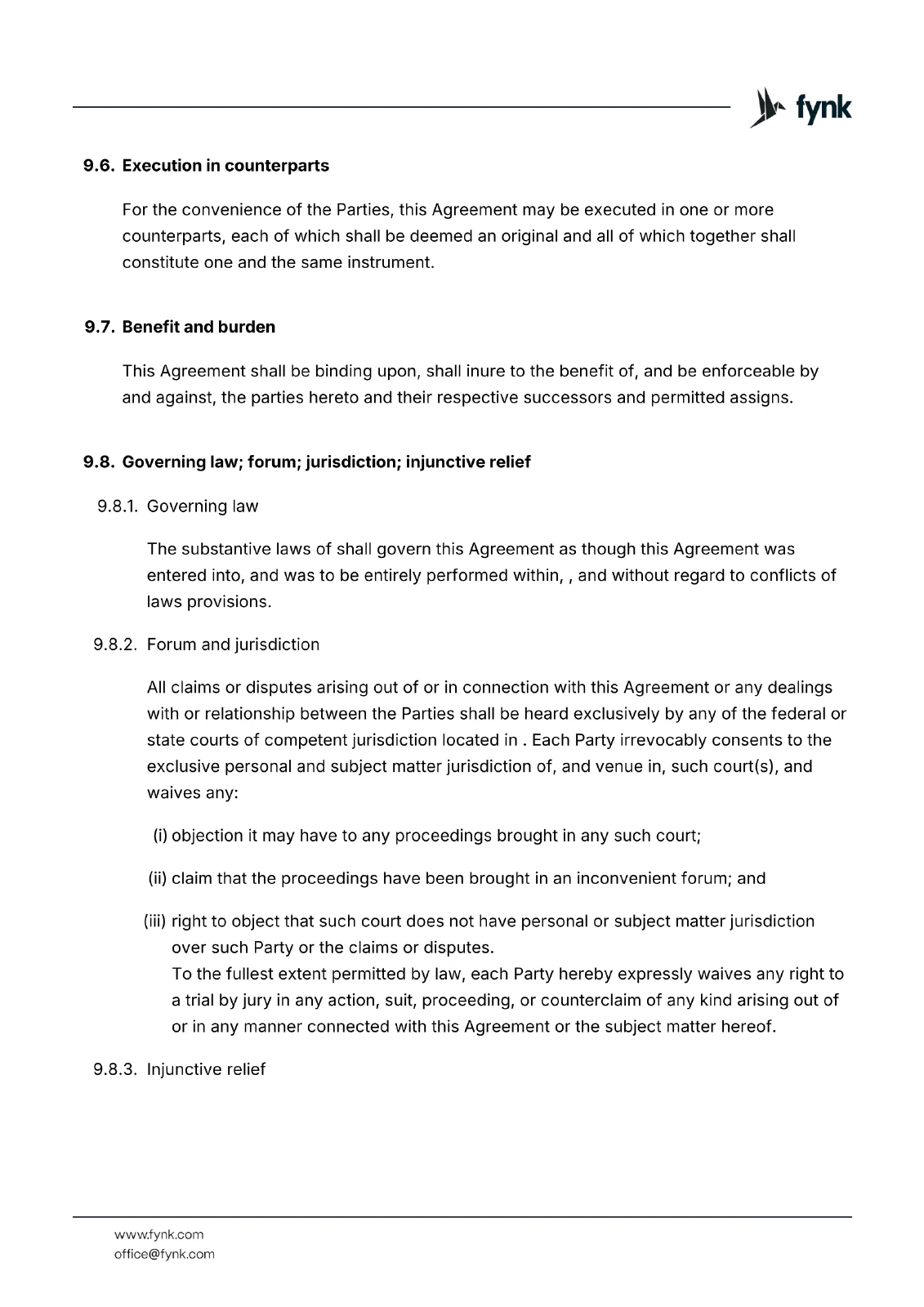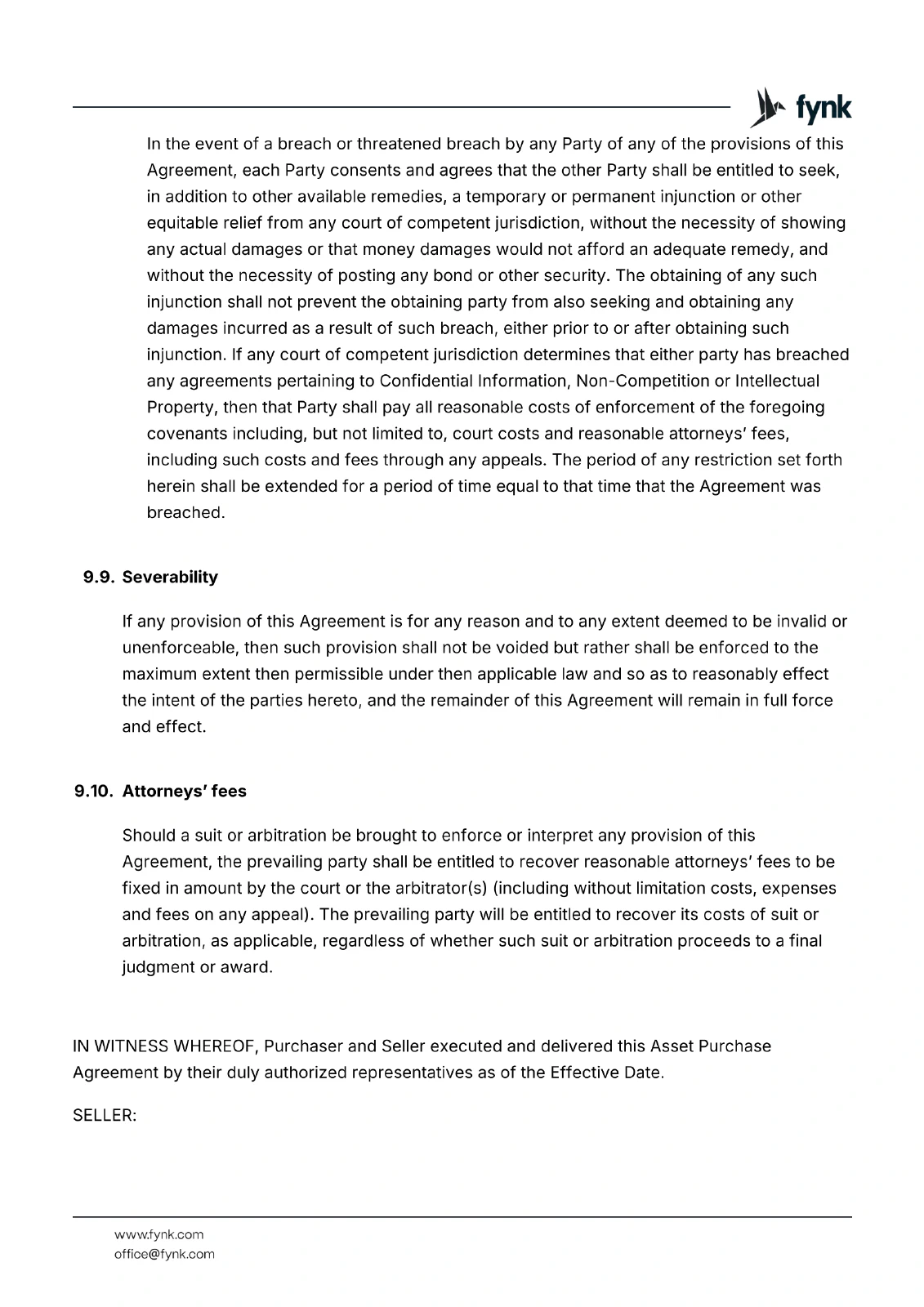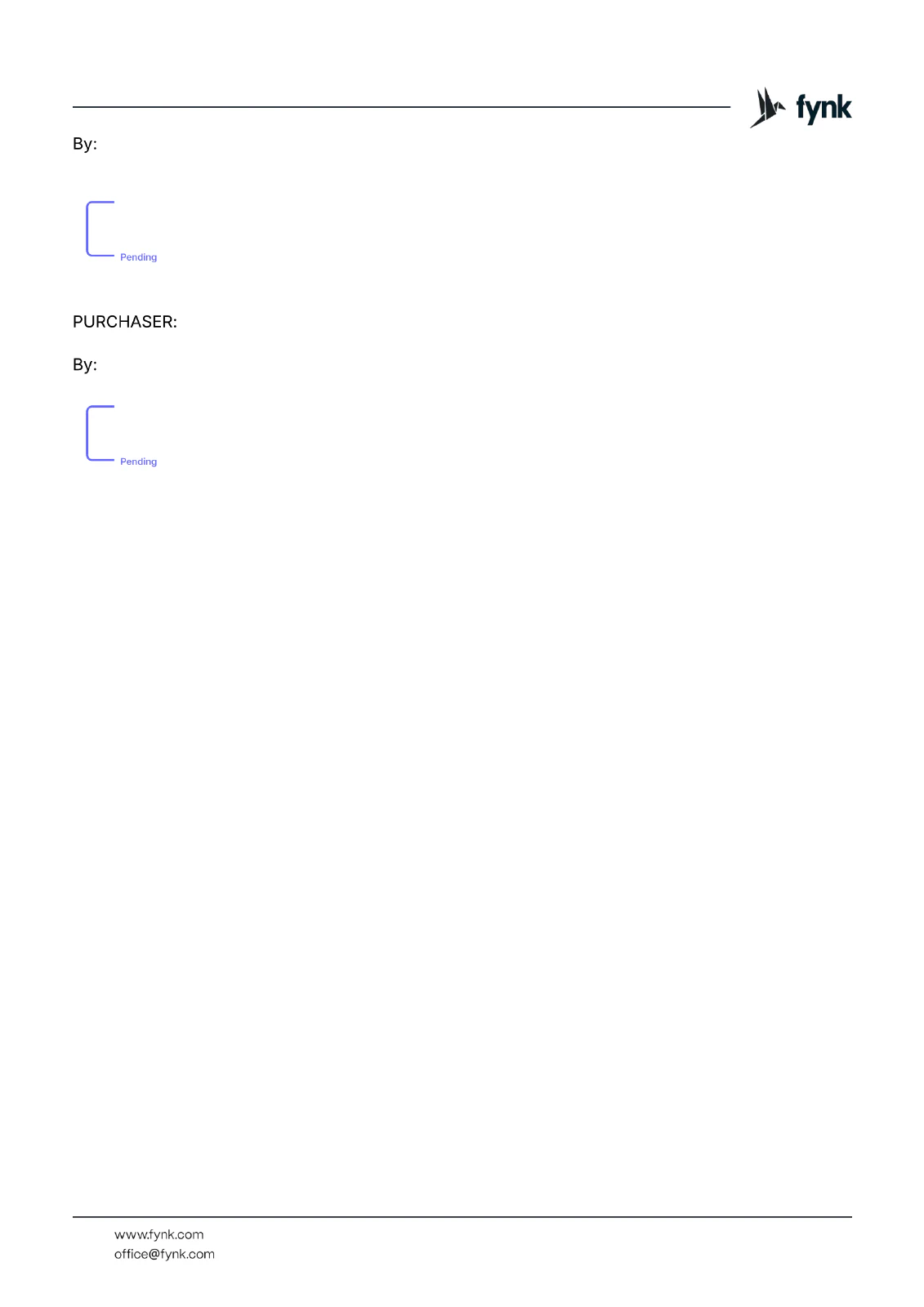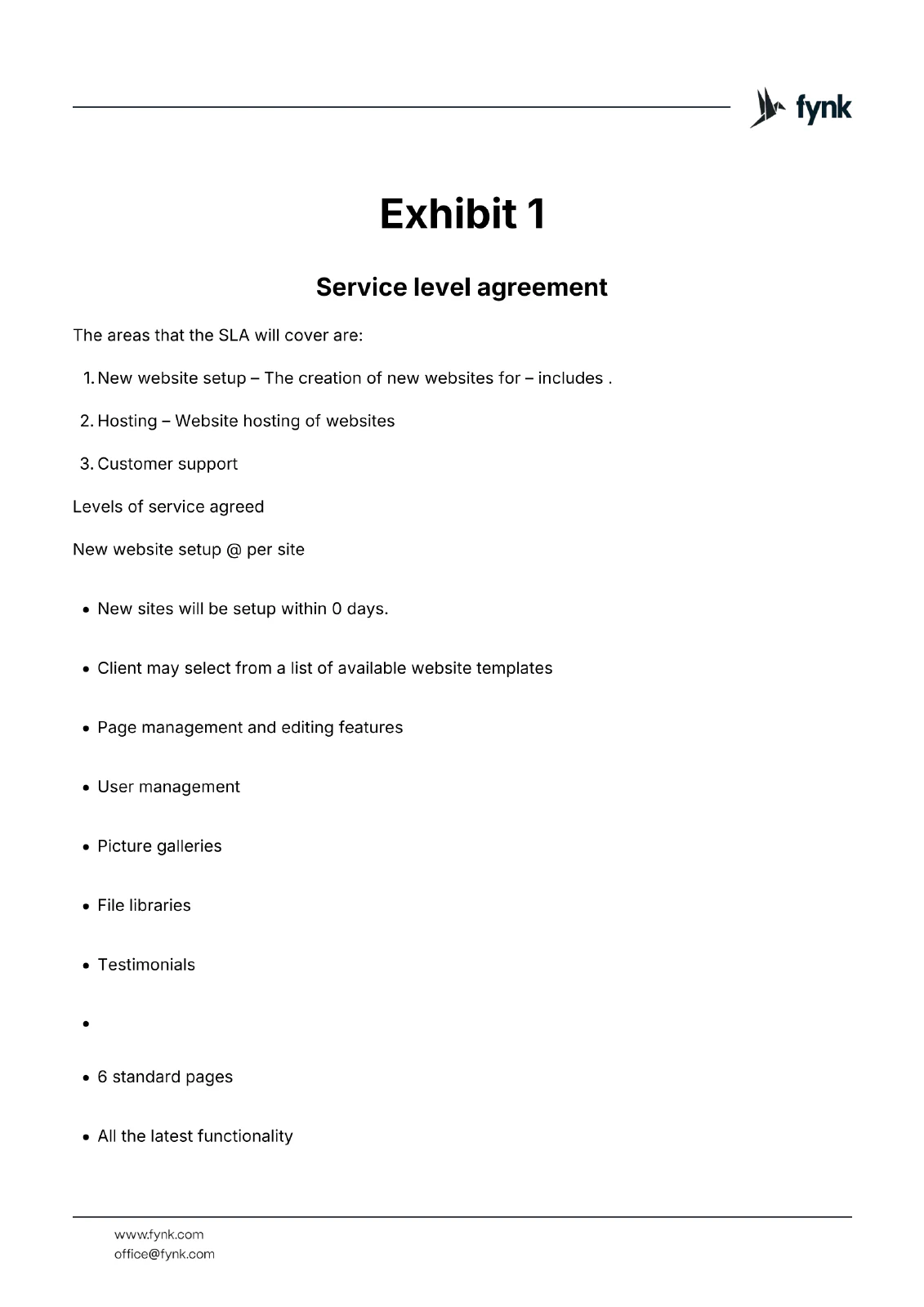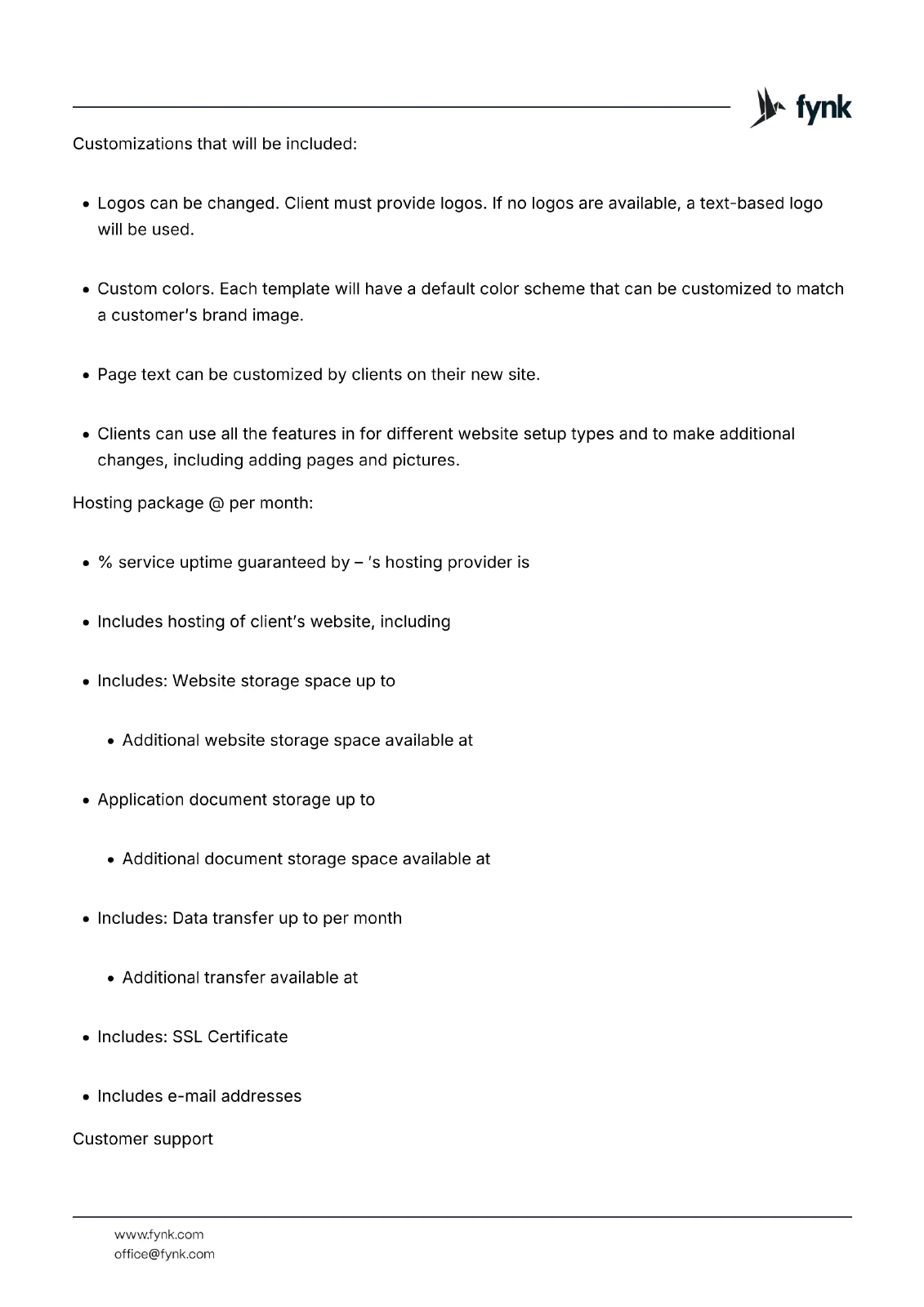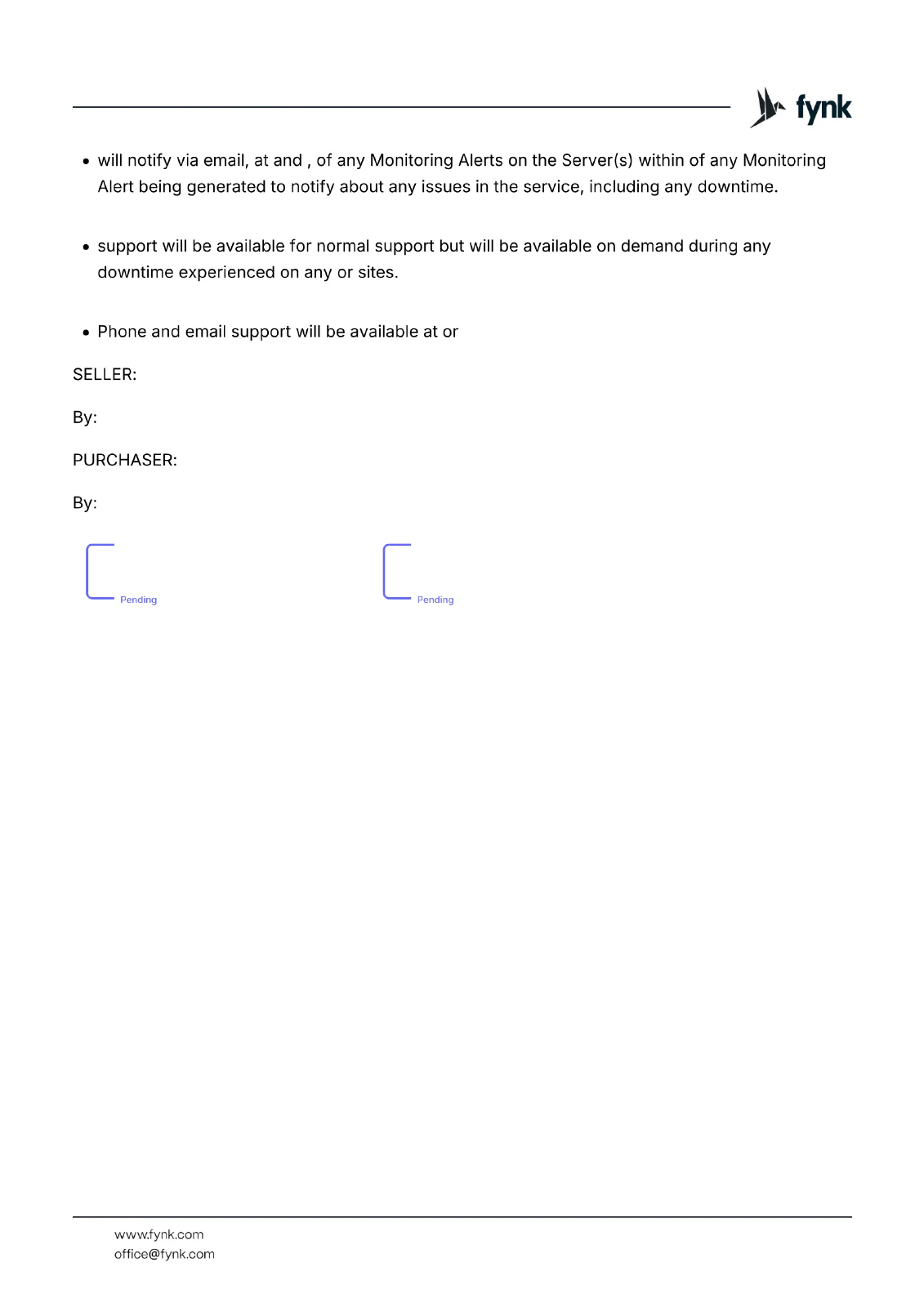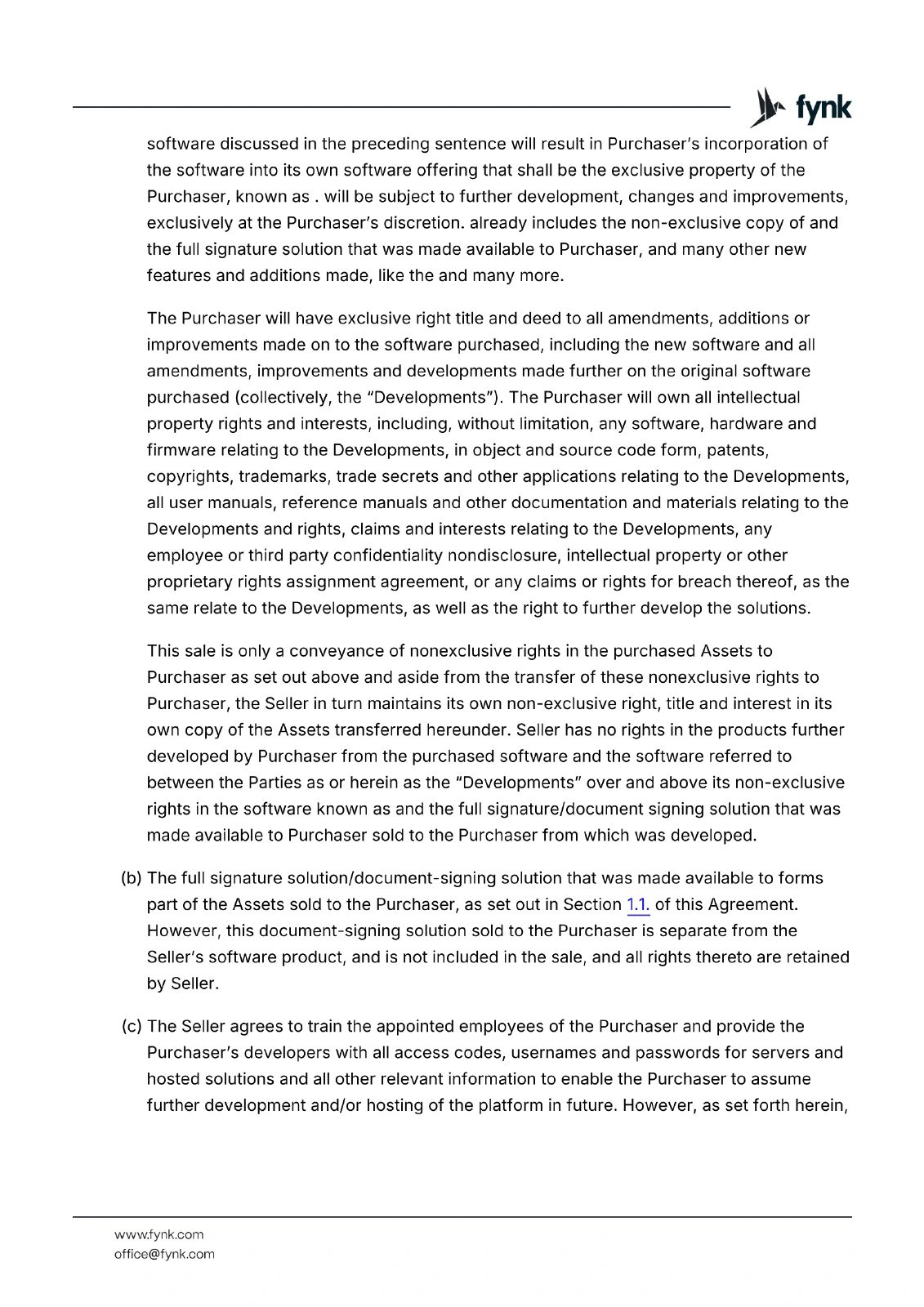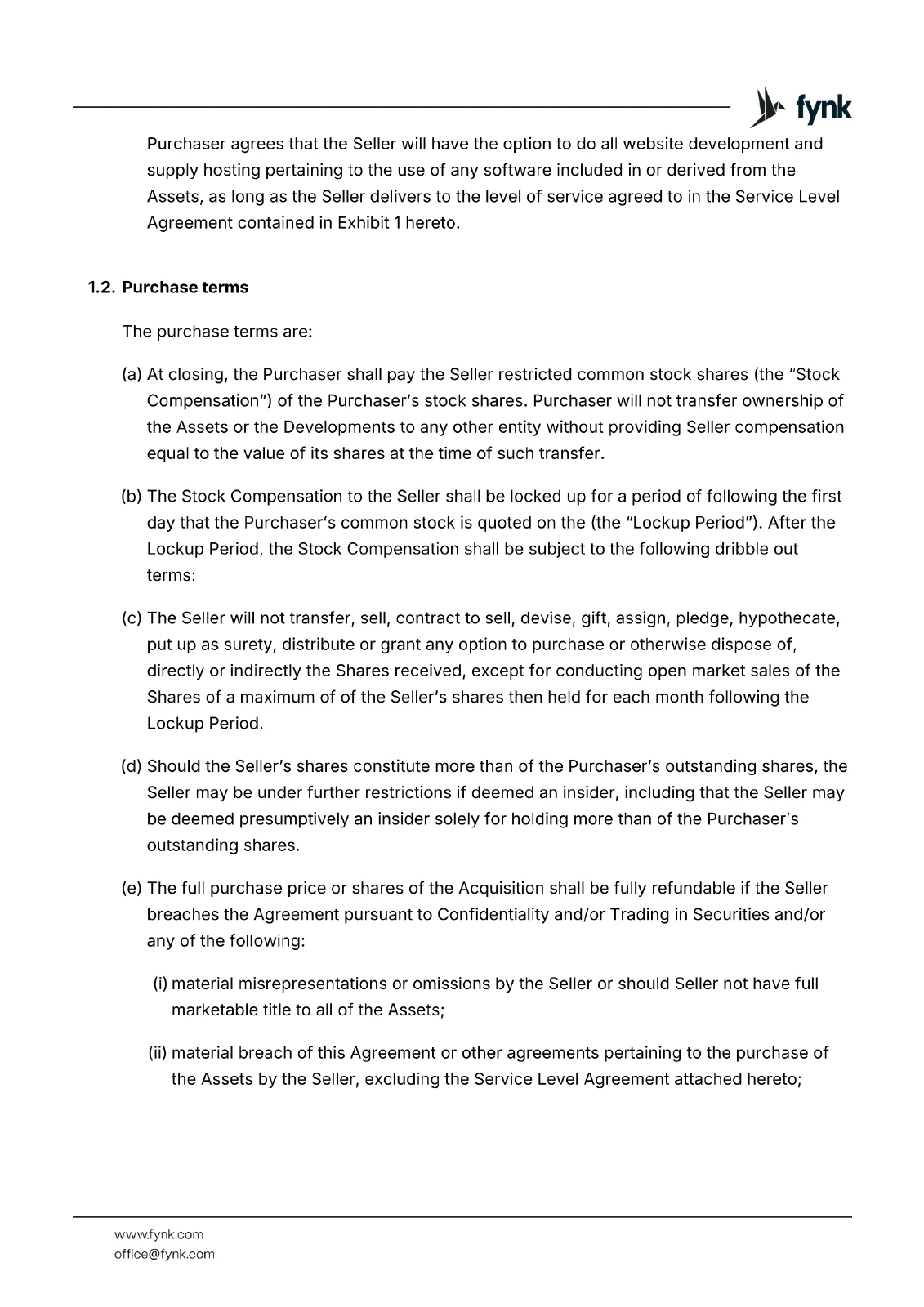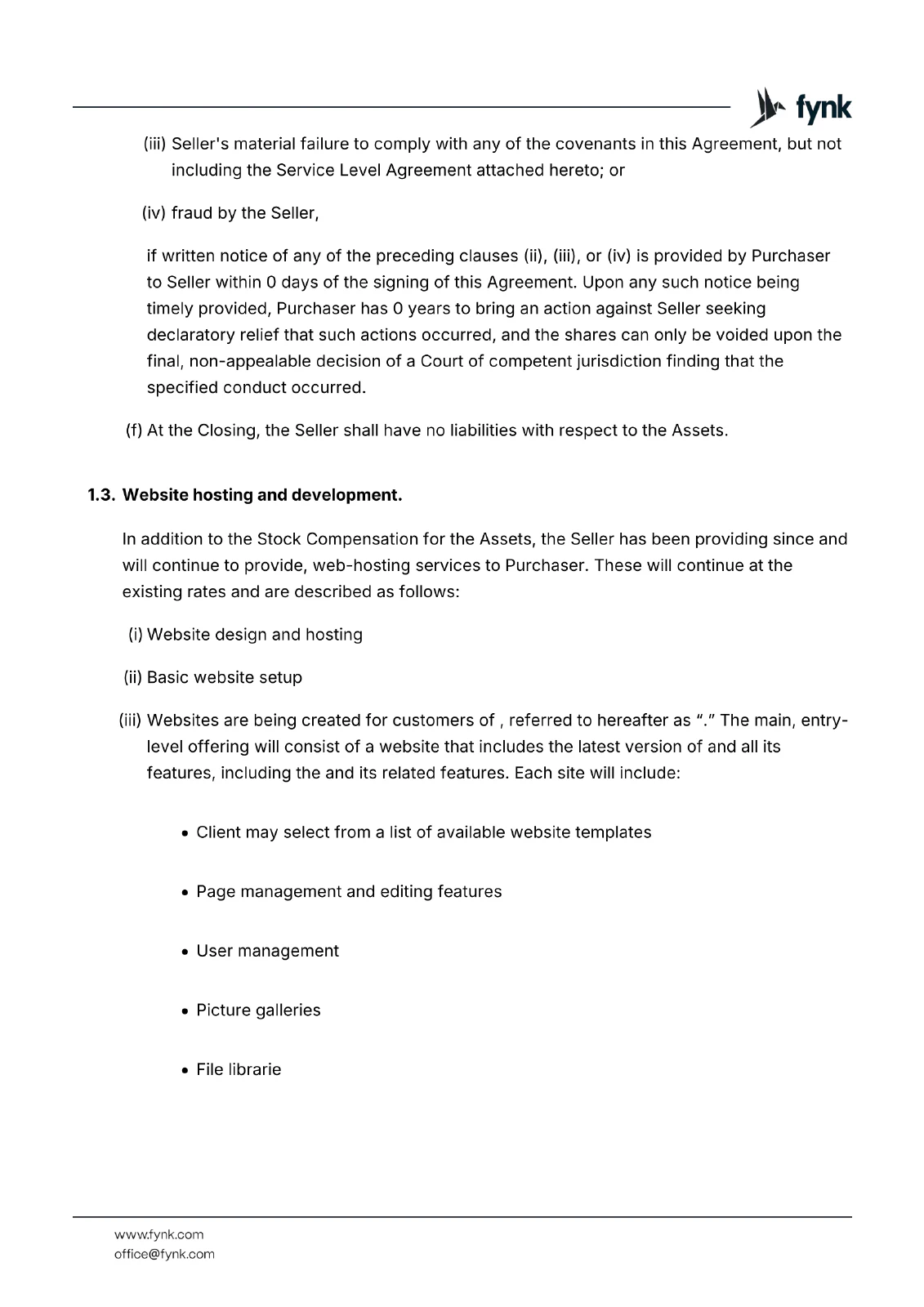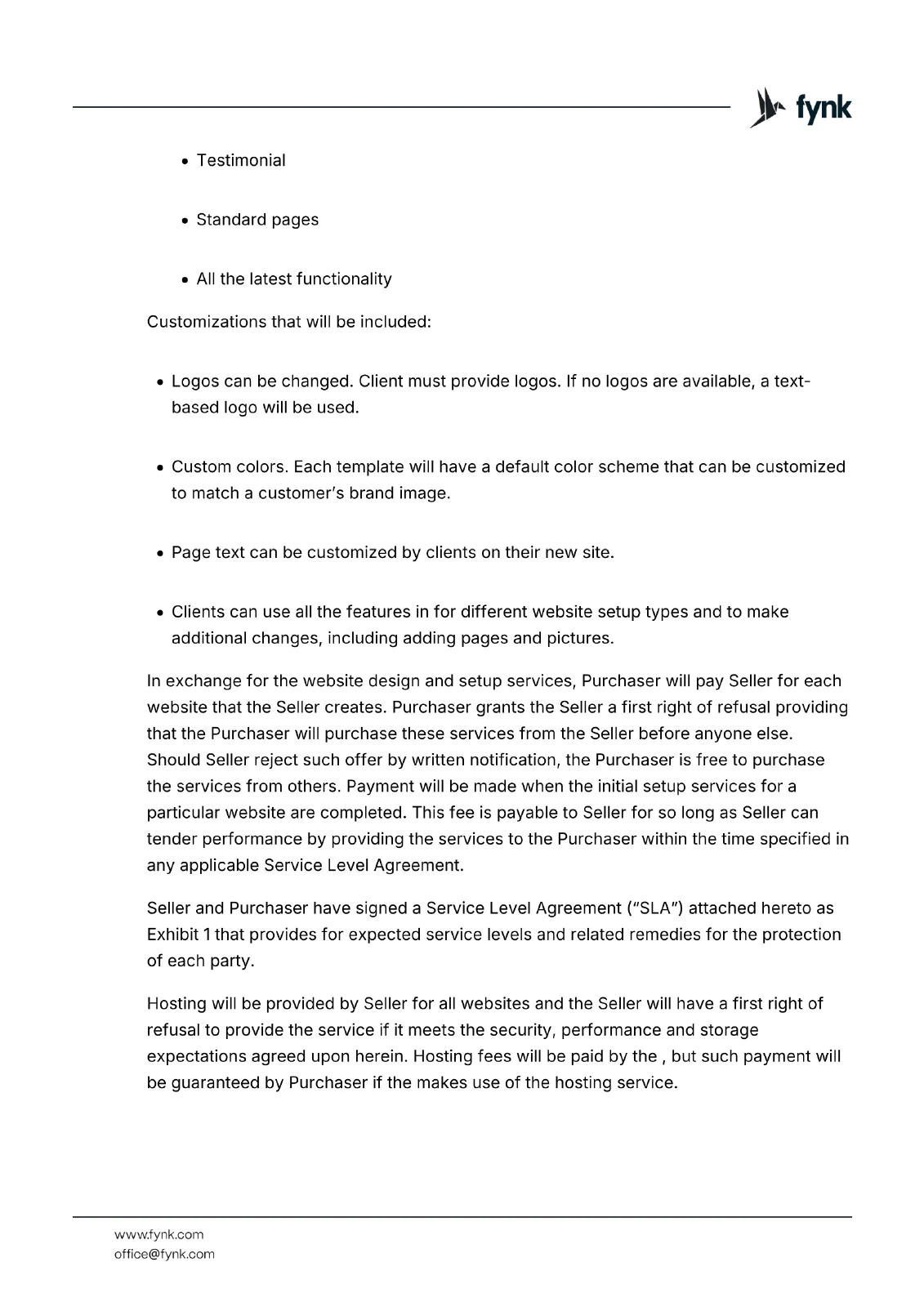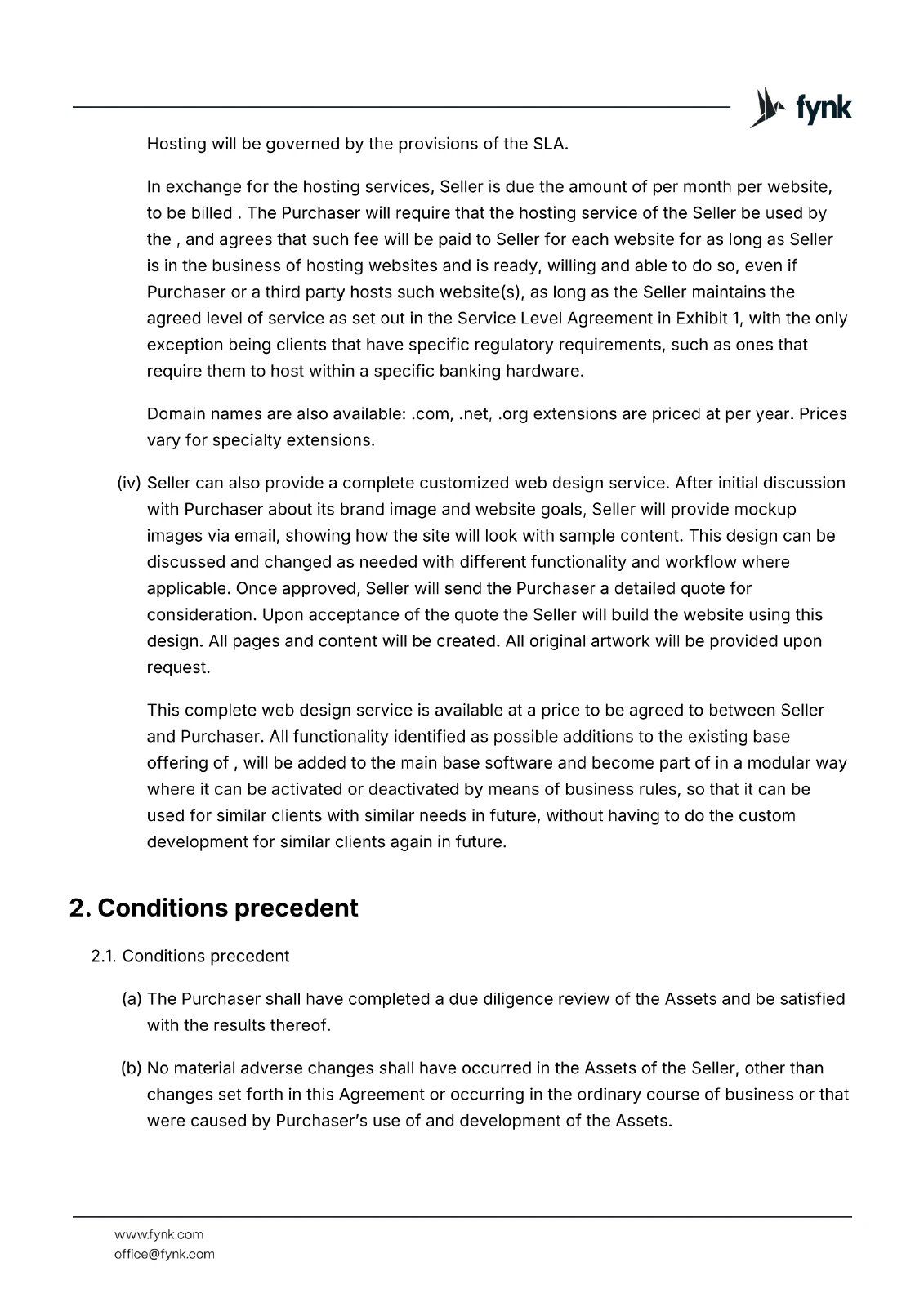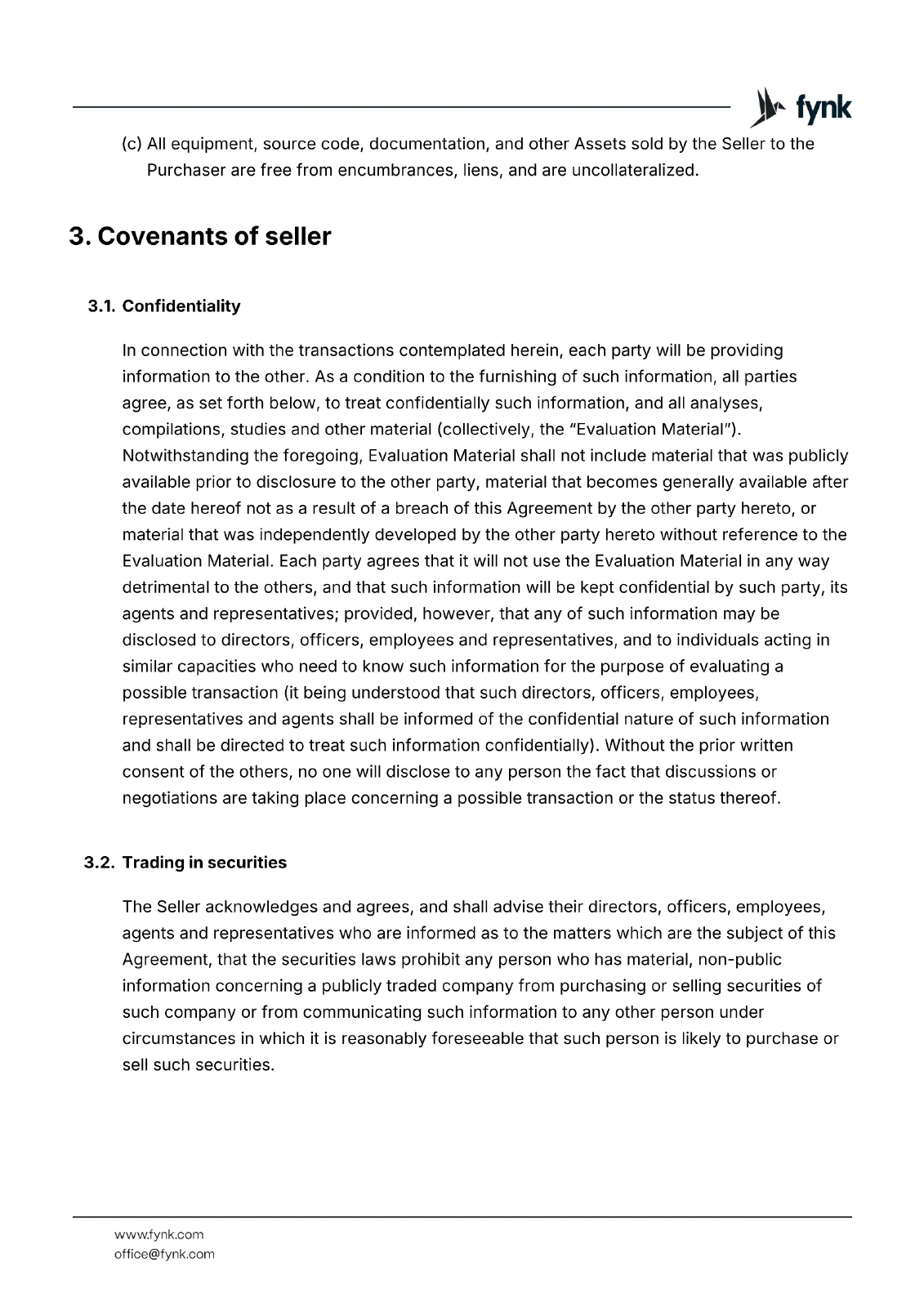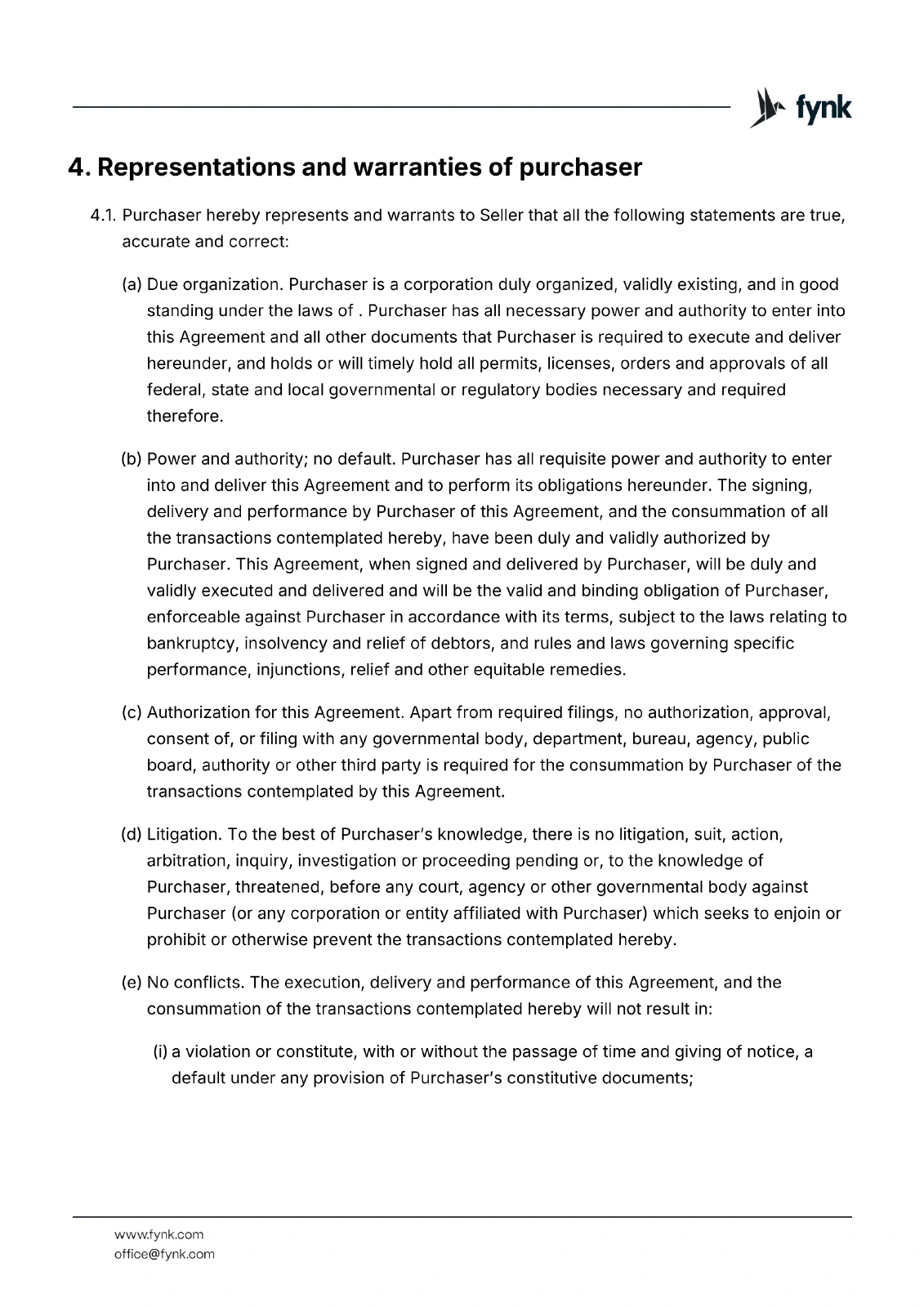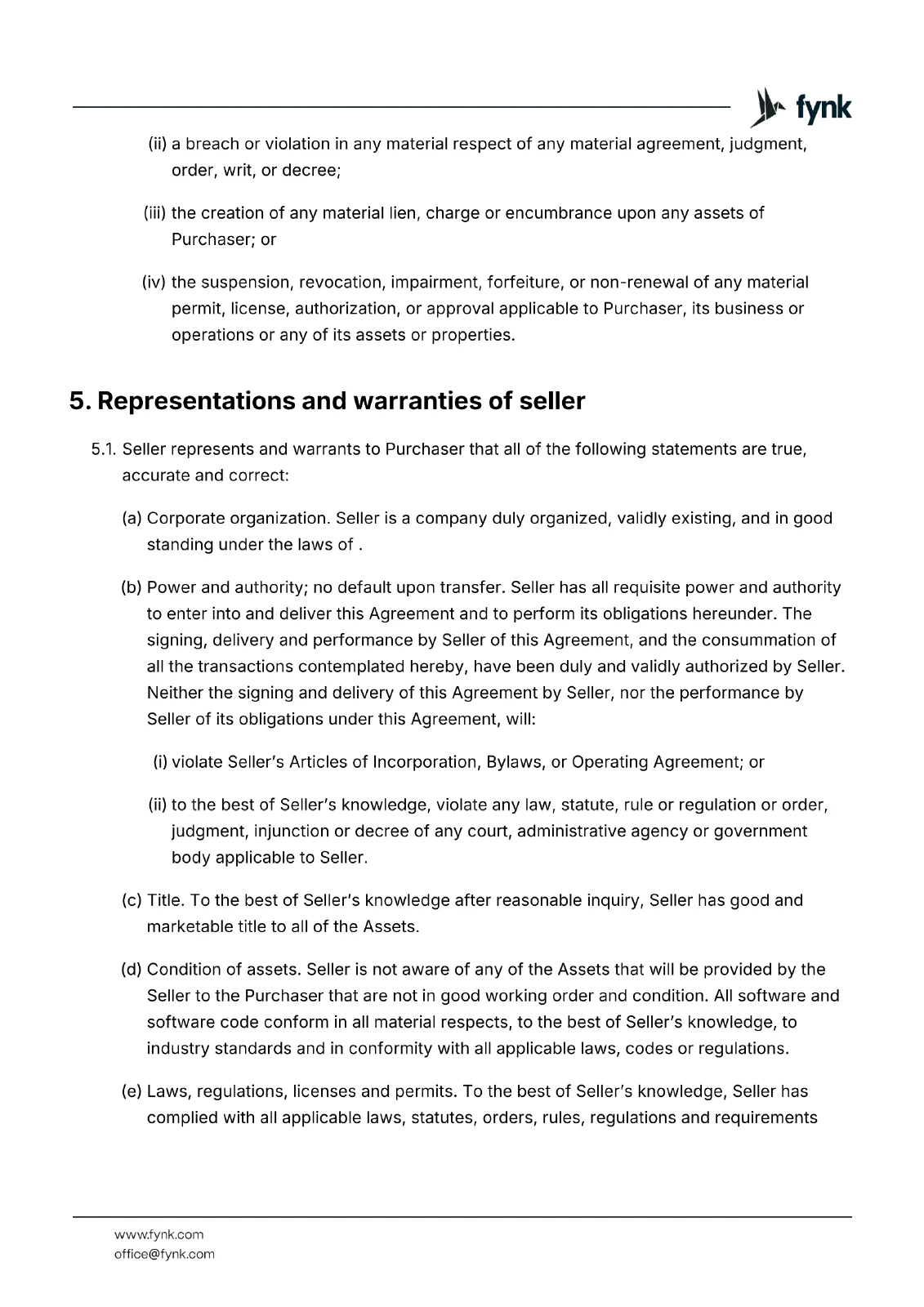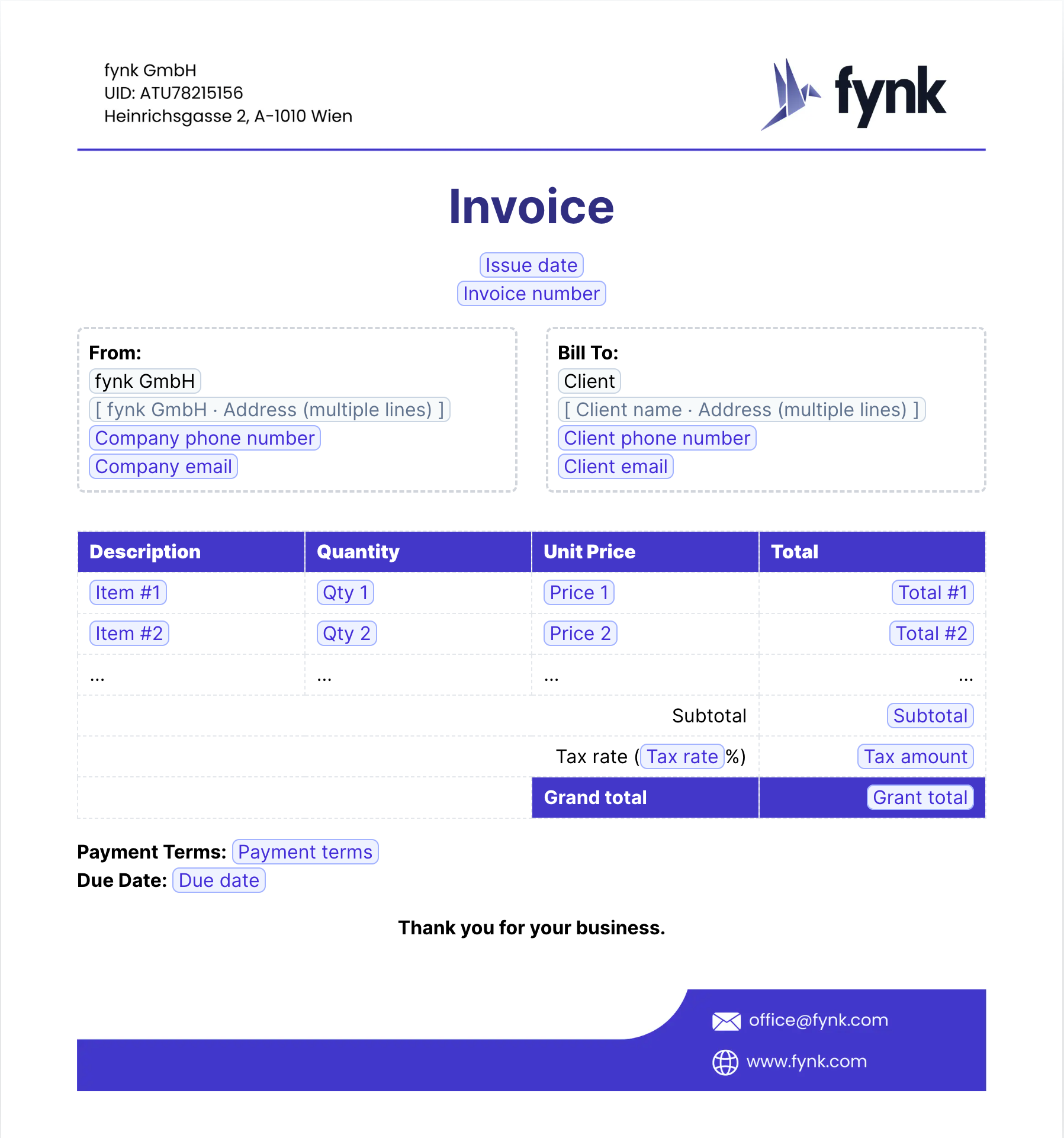Asset Purchase Agreement
(for Software)
Dated as of
Between
and
This ASSET PURCHASE AGREEMENT (“Agreement”), dated (“Effective Date”), is between (the “Purchaser”), a corporation, and , a corporation (the “Seller”). The Purchaser and the Seller are collectively referred to herein as the “Parties”.
Background
WHEREAS, both the Purchaser and the Seller are engaged in the business of developing and selling software and services.
WHEREAS, the Seller wishes to sell to Purchaser, and Purchaser wishes to acquire from Seller, the nonexclusive ownership of all of Seller’s Tangible and Intangible Assets (collectively the “Assets”) with respect to the software described in Section 1.1. below.
Sale of assets
The Parties agree as follows:
Assets to be sold
Upon the terms and conditions and in reliance on the representations, warranties and covenants set forth in this Agreement, Seller agrees to sell, assign, transfer, and convey to Purchaser at the Closing, a non-exclusive right, title and interest in and to the Assets, which are composed of a copy of the software platform. In addition, the software also includes a full signature/document signing solution that was made available to Purchaser. The Purchaser’s purchase of the non-exclusive right, title and interest in and to the software discussed in the preceding sentence will result in Purchaser’s incorporation of the software into its own software offering that shall be the exclusive property of the Purchaser, known as . will be subject to further development, changes and improvements, exclusively at the Purchaser’s discretion. already includes the non-exclusive copy of and the full signature solution that was made available to Purchaser, and many other new features and additions made, like the and many more.
The Purchaser will have exclusive right title and deed to all amendments, additions or improvements made on to the software purchased, including the new software and all amendments, improvements and developments made further on the original software purchased (collectively, the “Developments”). The Purchaser will own all intellectual property rights and interests, including, without limitation, any software, hardware and firmware relating to the Developments, in object and source code form, patents, copyrights, trademarks, trade secrets and other applications relating to the Developments, all user manuals, reference manuals and other documentation and materials relating to the Developments and rights, claims and interests relating to the Developments, any employee or third party confidentiality nondisclosure, intellectual property or other proprietary rights assignment agreement, or any claims or rights for breach thereof, as the same relate to the Developments, as well as the right to further develop the solutions.
This sale is only a conveyance of nonexclusive rights in the purchased Assets to Purchaser as set out above and aside from the transfer of these nonexclusive rights to Purchaser, the Seller in turn maintains its own non-exclusive right, title and interest in its own copy of the Assets transferred hereunder. Seller has no rights in the products further developed by Purchaser from the purchased software and the software referred to between the Parties as or herein as the “Developments” over and above its non-exclusive rights in the software known as and the full signature/document signing solution that was made available to Purchaser sold to the Purchaser from which was developed.
The full signature solution/document-signing solution that was made available to forms part of the Assets sold to the Purchaser, as set out in Section 1.1. of this Agreement. However, this document-signing solution sold to the Purchaser is separate from the Seller’s software product, and is not included in the sale, and all rights thereto are retained by Seller.
The Seller agrees to train the appointed employees of the Purchaser and provide the Purchaser’s developers with all access codes, usernames and passwords for servers and hosted solutions and all other relevant information to enable the Purchaser to assume further development and/or hosting of the platform in future. However, as set forth herein, Purchaser agrees that the Seller will have the option to do all website development and supply hosting pertaining to the use of any software included in or derived from the Assets, as long as the Seller delivers to the level of service agreed to in the Service Level Agreement contained in Exhibit 1 hereto.
Purchase terms
The purchase terms are:
At closing, the Purchaser shall pay the Seller restricted common stock shares (the “Stock Compensation”) of the Purchaser’s stock shares. Purchaser will not transfer ownership of the Assets or the Developments to any other entity without providing Seller compensation equal to the value of its shares at the time of such transfer.
The Stock Compensation to the Seller shall be locked up for a period of following the first day that the Purchaser’s common stock is quoted on the (the “Lockup Period”). After the Lockup Period, the Stock Compensation shall be subject to the following dribble out terms:
The Seller will not transfer, sell, contract to sell, devise, gift, assign, pledge, hypothecate, put up as surety, distribute or grant any option to purchase or otherwise dispose of, directly or indirectly the Shares received, except for conducting open market sales of the Shares of a maximum of of the Seller’s shares then held for each month following the Lockup Period.
Should the Seller’s shares constitute more than of the Purchaser’s outstanding shares, the Seller may be under further restrictions if deemed an insider, including that the Seller may be deemed presumptively an insider solely for holding more than of the Purchaser’s outstanding shares.
The full purchase price or shares of the Acquisition shall be fully refundable if the Seller breaches the Agreement pursuant to Confidentiality and/or Trading in Securities and/or any of the following:
material misrepresentations or omissions by the Seller or should Seller not have full marketable title to all of the Assets;
material breach of this Agreement or other agreements pertaining to the purchase of the Assets by the Seller, excluding the Service Level Agreement attached hereto;
Seller's material failure to comply with any of the covenants in this Agreement, but not including the Service Level Agreement attached hereto; or
fraud by the Seller,
if written notice of any of the preceding clauses (ii), (iii), or (iv) is provided by Purchaser to Seller within 0 days of the signing of this Agreement. Upon any such notice being timely provided, Purchaser has 0 years to bring an action against Seller seeking declaratory relief that such actions occurred, and the shares can only be voided upon the final, non-appealable decision of a Court of competent jurisdiction finding that the specified conduct occurred.
At the Closing, the Seller shall have no liabilities with respect to the Assets.
Website hosting and development.
In addition to the Stock Compensation for the Assets, the Seller has been providing since and will continue to provide, web-hosting services to Purchaser. These will continue at the existing rates and are described as follows:
Website design and hosting
Basic website setup
Websites are being created for customers of , referred to hereafter as “.” The main, entry-level offering will consist of a website that includes the latest version of and all its features, including the and its related features. Each site will include:
Client may select from a list of available website templates
Page management and editing features
User management
Picture galleries
File librarie
Testimonial
Standard pages
All the latest functionality
Customizations that will be included:
Logos can be changed. Client must provide logos. If no logos are available, a text-based logo will be used.
Custom colors. Each template will have a default color scheme that can be customized to match a customer’s brand image.
Page text can be customized by clients on their new site.
Clients can use all the features in for different website setup types and to make additional changes, including adding pages and pictures.
In exchange for the website design and setup services, Purchaser will pay Seller for each website that the Seller creates. Purchaser grants the Seller a first right of refusal providing that the Purchaser will purchase these services from the Seller before anyone else. Should Seller reject such offer by written notification, the Purchaser is free to purchase the services from others. Payment will be made when the initial setup services for a particular website are completed. This fee is payable to Seller for so long as Seller can tender performance by providing the services to the Purchaser within the time specified in any applicable Service Level Agreement.
Seller and Purchaser have signed a Service Level Agreement (“SLA”) attached hereto as Exhibit 1 that provides for expected service levels and related remedies for the protection of each party.
Hosting will be provided by Seller for all websites and the Seller will have a first right of refusal to provide the service if it meets the security, performance and storage expectations agreed upon herein. Hosting fees will be paid by the , but such payment will be guaranteed by Purchaser if the makes use of the hosting service.
Hosting will be governed by the provisions of the SLA.
In exchange for the hosting services, Seller is due the amount of per month per website, to be billed . The Purchaser will require that the hosting service of the Seller be used by the , and agrees that such fee will be paid to Seller for each website for as long as Seller is in the business of hosting websites and is ready, willing and able to do so, even if Purchaser or a third party hosts such website(s), as long as the Seller maintains the agreed level of service as set out in the Service Level Agreement in Exhibit 1, with the only exception being clients that have specific regulatory requirements, such as ones that require them to host within a specific banking hardware.
Domain names are also available: .com, .net, .org extensions are priced at per year. Prices vary for specialty extensions.
Seller can also provide a complete customized web design service. After initial discussion with Purchaser about its brand image and website goals, Seller will provide mockup images via email, showing how the site will look with sample content. This design can be discussed and changed as needed with different functionality and workflow where applicable. Once approved, Seller will send the Purchaser a detailed quote for consideration. Upon acceptance of the quote the Seller will build the website using this design. All pages and content will be created. All original artwork will be provided upon request.
This complete web design service is available at a price to be agreed to between Seller and Purchaser. All functionality identified as possible additions to the existing base offering of , will be added to the main base software and become part of in a modular way where it can be activated or deactivated by means of business rules, so that it can be used for similar clients with similar needs in future, without having to do the custom development for similar clients again in future.
Conditions precedent
Conditions precedent
The Purchaser shall have completed a due diligence review of the Assets and be satisfied with the results thereof.
No material adverse changes shall have occurred in the Assets of the Seller, other than changes set forth in this Agreement or occurring in the ordinary course of business or that were caused by Purchaser’s use of and development of the Assets.
All equipment, source code, documentation, and other Assets sold by the Seller to the Purchaser are free from encumbrances, liens, and are uncollateralized.
Covenants of seller
Confidentiality
In connection with the transactions contemplated herein, each party will be providing information to the other. As a condition to the furnishing of such information, all parties agree, as set forth below, to treat confidentially such information, and all analyses, compilations, studies and other material (collectively, the “Evaluation Material”). Notwithstanding the foregoing, Evaluation Material shall not include material that was publicly available prior to disclosure to the other party, material that becomes generally available after the date hereof not as a result of a breach of this Agreement by the other party hereto, or material that was independently developed by the other party hereto without reference to the Evaluation Material. Each party agrees that it will not use the Evaluation Material in any way detrimental to the others, and that such information will be kept confidential by such party, its agents and representatives; provided, however, that any of such information may be disclosed to directors, officers, employees and representatives, and to individuals acting in similar capacities who need to know such information for the purpose of evaluating a possible transaction (it being understood that such directors, officers, employees, representatives and agents shall be informed of the confidential nature of such information and shall be directed to treat such information confidentially). Without the prior written consent of the others, no one will disclose to any person the fact that discussions or negotiations are taking place concerning a possible transaction or the status thereof.
Trading in securities
The Seller acknowledges and agrees, and shall advise their directors, officers, employees, agents and representatives who are informed as to the matters which are the subject of this Agreement, that the securities laws prohibit any person who has material, non-public information concerning a publicly traded company from purchasing or selling securities of such company or from communicating such information to any other person under circumstances in which it is reasonably foreseeable that such person is likely to purchase or sell such securities.
Representations and warranties of purchaser
Purchaser hereby represents and warrants to Seller that all the following statements are true, accurate and correct:
Due organization. Purchaser is a corporation duly organized, validly existing, and in good standing under the laws of . Purchaser has all necessary power and authority to enter into this Agreement and all other documents that Purchaser is required to execute and deliver hereunder, and holds or will timely hold all permits, licenses, orders and approvals of all federal, state and local governmental or regulatory bodies necessary and required therefore.
Power and authority; no default. Purchaser has all requisite power and authority to enter into and deliver this Agreement and to perform its obligations hereunder. The signing, delivery and performance by Purchaser of this Agreement, and the consummation of all the transactions contemplated hereby, have been duly and validly authorized by Purchaser. This Agreement, when signed and delivered by Purchaser, will be duly and validly executed and delivered and will be the valid and binding obligation of Purchaser, enforceable against Purchaser in accordance with its terms, subject to the laws relating to bankruptcy, insolvency and relief of debtors, and rules and laws governing specific performance, injunctions, relief and other equitable remedies.
Authorization for this Agreement. Apart from required filings, no authorization, approval, consent of, or filing with any governmental body, department, bureau, agency, public board, authority or other third party is required for the consummation by Purchaser of the transactions contemplated by this Agreement.
Litigation. To the best of Purchaser’s knowledge, there is no litigation, suit, action, arbitration, inquiry, investigation or proceeding pending or, to the knowledge of Purchaser, threatened, before any court, agency or other governmental body against Purchaser (or any corporation or entity affiliated with Purchaser) which seeks to enjoin or prohibit or otherwise prevent the transactions contemplated hereby.
No conflicts. The execution, delivery and performance of this Agreement, and the consummation of the transactions contemplated hereby will not result in:
a violation or constitute, with or without the passage of time and giving of notice, a default under any provision of Purchaser’s constitutive documents;
a breach or violation in any material respect of any material agreement, judgment, order, writ, or decree;
the creation of any material lien, charge or encumbrance upon any assets of Purchaser; or
the suspension, revocation, impairment, forfeiture, or non-renewal of any material permit, license, authorization, or approval applicable to Purchaser, its business or operations or any of its assets or properties.
Representations and warranties of seller
Seller represents and warrants to Purchaser that all of the following statements are true, accurate and correct:
Corporate organization. Seller is a company duly organized, validly existing, and in good standing under the laws of .
Power and authority; no default upon transfer. Seller has all requisite power and authority to enter into and deliver this Agreement and to perform its obligations hereunder. The signing, delivery and performance by Seller of this Agreement, and the consummation of all the transactions contemplated hereby, have been duly and validly authorized by Seller. Neither the signing and delivery of this Agreement by Seller, nor the performance by Seller of its obligations under this Agreement, will:
violate Seller’s Articles of Incorporation, Bylaws, or Operating Agreement; or
to the best of Seller’s knowledge, violate any law, statute, rule or regulation or order, judgment, injunction or decree of any court, administrative agency or government body applicable to Seller.
Title. To the best of Seller’s knowledge after reasonable inquiry, Seller has good and marketable title to all of the Assets.
Condition of assets. Seller is not aware of any of the Assets that will be provided by the Seller to the Purchaser that are not in good working order and condition. All software and software code conform in all material respects, to the best of Seller’s knowledge, to industry standards and in conformity with all applicable laws, codes or regulations.
Laws, regulations, licenses and permits. To the best of Seller’s knowledge, Seller has complied with all applicable laws, statutes, orders, rules, regulations and requirements promulgated by governmental or other authorities relating to the Assets. Seller has not received any notice of any sort of alleged violation of any such statute, order, rule, regulation or requirement that would have any adverse impact upon the Assets.
Absence of undisclosed liabilities. Seller is not aware of any liabilities or obligations of any nature, whether secured or unsecured, disclosed or undisclosed, accrued, absolute, contingent or otherwise, whether due or to become due, that would, individually or in the aggregate, materially affect the Assets.
Disclaimer of other representations. Except for the representations and warranties expressly set forth in this agreement or established by applicable law as rights that cannot be waived or limited by contract, each party disclaims all representations and warranties, including any implied warranty of merchantability or fitness for a particular purpose.
Conditions to closing
Conditions to purchaser’s obligations
The obligations of the Seller hereunder shall be subject to the satisfaction and fulfillment of each of the following conditions, except as Purchaser may expressly waive the same in writing:
Accuracy of representations and warranties on closing date. The representations and warranties made herein by Seller shall be true and correct in all material respects, and not misleading in any material respect, on and as of the date given, and on and as of the Closing Date with the same force and effect as though such representations and warranties were made on and as of the Closing Date.
Compliance. As of the Closing Date, Seller shall have complied in all material respects with, and shall have fully performed, in all material respects, all conditions, covenants and obligations of this Agreement imposed on Seller and required to be performed or complied with by Seller at, or prior to, the Closing Date.
Delivery of assets. Seller shall have delivered the Assets to the Purchaser.
Delivery of closing documents. Seller shall have delivered, and Purchaser shall have received, the documents reflected in Exhibit 1.
Conditions to seller’s obligations
The obligations of the Purchaser hereunder shall be subject to the satisfaction and fulfillment of each of the following conditions, except as Seller may expressly waive the same in writing:
Accuracy of representations and warranties on closing date. The representations and warranties made herein by Purchaser in Section 4. hereof shall be true and correct in all material respects, and not misleading in any material respect, on and as of the date given, and on and as of the Closing Date with the same force and effect as though such representations and warranties were made on and as of the Closing Date.
Compliance. Purchaser shall have complied in all material respects with, and shall have fully performed, the terms, conditions, covenants and obligations of this Agreement imposed thereon to be performed or complied with by Purchaser at, or prior to, the Closing Date.
Payment. Purchaser shall have transmitted by issuance of a stock certificate for shares (the “Stock Certificate”) issued by the Purchaser’s transfer agent.
Closing obligations
Purchaser’s closing obligations
Prior to or at the Closing, Purchaser shall deliver or effect the delivery to Seller of the stock certificate reflecting the .
Seller’s closing obligations
At the Closing, Seller shall deliver the Assets to the Purchaser.
Survival of warranties and indemnification
Survival of warranties
All representations and warranties made by Seller or Purchaser herein, or in any certificate, schedule or exhibit delivered pursuant hereto, shall survive the Closing for a period of after the Closing.
Indemnified losses
For the purpose of this section and when used elsewhere in this Agreement, “Loss” shall mean and include any and all liability, loss, damage, claim, expense, cost, fine, fee, penalty, obligation or injury including, without limitation, those resulting from any and all actions, suits, proceedings, demands, assessments, judgments, awards or arbitration, together with reasonable costs and expenses including the reasonable attorneys’ fees and other legal costs and expenses relating thereto.
No indemnification by seller
Seller is selling to Purchaser right, title and interest in and to the Assets defined in this Agreement “as is” and “where is”, with no representations or warranties as to merchantability, fitness or usability or in any other regard (except for the limited representations and warranties specifically set forth above) and does not agree to defend, indemnify or hold harmless Purchaser, any parent, subsidiary or affiliate of Purchaser or any director, officer, employee, stockholder, agent or attorney of Purchaser or of any parent, subsidiary or affiliate of Purchaser from and against and in respect of any Loss which arises out of or results from the transaction described herein; provided, however, that nothing in this section shall relieve Seller of any liability for breach of this Agreement.
Indemnification by purchaser
Subject to the provisions and limitations set forth in this section, Purchaser agrees to defend, indemnify and hold harmless Seller, any parent, subsidiary or affiliate of Seller and any director, officer, employee, stockholder, agent or attorney of Seller or of any parent, subsidiary or affiliate of Seller (collectively, the “Seller Indemnitees”) from and against and in respect of any Loss which arises out of or results from:
any breach by Purchaser of any covenant, or the inaccuracy or untruth of any representation or warranty of Purchaser made herein; or
the use of the Assets after the Closing.
Miscellaneous
Expenses
Each of the Parties hereto shall bear its own expenses (including without limitation attorneys’ fees) in connection with the negotiation and consummation of the transaction contemplated hereby.
Notices
Any notice required or permitted to be given under this Agreement shall be in writing and shall be personally delivered, sent by certified or registered mail (postage prepaid), or by nationally recognized overnight express courier, addressed as follows:
If to Seller:
If to Purchaser:
Entire agreement
This Asset Purchase Agreement and any agreements to be executed and delivered in connection herewith or therewith, together constitute the entire agreement and understanding between the parties and there are no agreements or commitments with respect to the transactions contemplated herein except as set forth in this Agreement. This Agreement supersedes any prior offer, agreement or understanding between the parties with respect to the transactions contemplated hereby.
Amendment; waiver
Any term or provision of this Agreement may be amended only by a writing signed by Seller and Purchaser. The observance of any term or provision of this Agreement may be waived (either generally or in a particular instance and either retroactively or prospectively) only by a writing signed by the party to be bound by such waiver. No waiver by a party of any breach of this Agreement will be deemed to constitute a waiver of any other breach or any succeeding breach.
No third-party beneficiaries
Nothing expressed or implied in this Agreement is intended, or shall be construed, to confer upon or to give any person, firm or corporation, other than the parties hereto, any rights or remedies under or by reason of this Agreement.
Execution in counterparts
For the convenience of the Parties, this Agreement may be executed in one or more counterparts, each of which shall be deemed an original and all of which together shall constitute one and the same instrument.
Benefit and burden
This Agreement shall be binding upon, shall inure to the benefit of, and be enforceable by and against, the parties hereto and their respective successors and permitted assigns.
Governing law; forum; jurisdiction; injunctive relief
Governing law
The substantive laws of shall govern this Agreement as though this Agreement was entered into, and was to be entirely performed within, , and without regard to conflicts of laws provisions.
Forum and jurisdiction
All claims or disputes arising out of or in connection with this Agreement or any dealings with or relationship between the Parties shall be heard exclusively by any of the federal or state courts of competent jurisdiction located in . Each Party irrevocably consents to the exclusive personal and subject matter jurisdiction of, and venue in, such court(s), and waives any:
objection it may have to any proceedings brought in any such court;
claim that the proceedings have been brought in an inconvenient forum; and
right to object that such court does not have personal or subject matter jurisdiction over such Party or the claims or disputes.
To the fullest extent permitted by law, each Party hereby expressly waives any right to a trial by jury in any action, suit, proceeding, or counterclaim of any kind arising out of or in any manner connected with this Agreement or the subject matter hereof.
Injunctive relief
In the event of a breach or threatened breach by any Party of any of the provisions of this Agreement, each Party consents and agrees that the other Party shall be entitled to seek, in addition to other available remedies, a temporary or permanent injunction or other equitable relief from any court of competent jurisdiction, without the necessity of showing any actual damages or that money damages would not afford an adequate remedy, and without the necessity of posting any bond or other security. The obtaining of any such injunction shall not prevent the obtaining party from also seeking and obtaining any damages incurred as a result of such breach, either prior to or after obtaining such injunction. If any court of competent jurisdiction determines that either party has breached any agreements pertaining to Confidential Information, Non-Competition or Intellectual Property, then that Party shall pay all reasonable costs of enforcement of the foregoing covenants including, but not limited to, court costs and reasonable attorneys’ fees, including such costs and fees through any appeals. The period of any restriction set forth herein shall be extended for a period of time equal to that time that the Agreement was breached.
Severability
If any provision of this Agreement is for any reason and to any extent deemed to be invalid or unenforceable, then such provision shall not be voided but rather shall be enforced to the maximum extent then permissible under then applicable law and so as to reasonably effect the intent of the parties hereto, and the remainder of this Agreement will remain in full force and effect.
Attorneys’ fees
Should a suit or arbitration be brought to enforce or interpret any provision of this Agreement, the prevailing party shall be entitled to recover reasonable attorneys’ fees to be fixed in amount by the court or the arbitrator(s) (including without limitation costs, expenses and fees on any appeal). The prevailing party will be entitled to recover its costs of suit or arbitration, as applicable, regardless of whether such suit or arbitration proceeds to a final judgment or award.
IN WITNESS WHEREOF, Purchaser and Seller executed and delivered this Asset Purchase Agreement by their duly authorized representatives as of the Effective Date.
SELLER:
By:
PURCHASER:
By:
Exhibit 1
Service level agreement
The areas that the SLA will cover are:
New website setup – The creation of new websites for – includes .
Hosting – Website hosting of websites
Customer support
Levels of service agreed
New website setup @ per site
New sites will be setup within 0 days.
Client may select from a list of available website templates
Page management and editing features
User management
Picture galleries
File libraries
Testimonials
6 standard pages
All the latest functionality
Customizations that will be included:
Logos can be changed. Client must provide logos. If no logos are available, a text-based logo will be used.
Custom colors. Each template will have a default color scheme that can be customized to match a customer’s brand image.
Page text can be customized by clients on their new site.
Clients can use all the features in for different website setup types and to make additional changes, including adding pages and pictures.
Hosting package @ per month:
% service uptime guaranteed by – ’s hosting provider is
Includes hosting of client’s website, including
Includes: Website storage space up to
Additional website storage space available at
Application document storage up to
Additional document storage space available at
Includes: Data transfer up to per month
Additional transfer available at
Includes: SSL Certificate
Includes e-mail addresses
Customer support
will notify via email, at and , of any Monitoring Alerts on the Server(s) within of any Monitoring Alert being generated to notify about any issues in the service, including any downtime.
support will be available for normal support but will be available on demand during any downtime experienced on any or sites.
Phone and email support will be available at or
SELLER:
By:
PURCHASER:
By:

